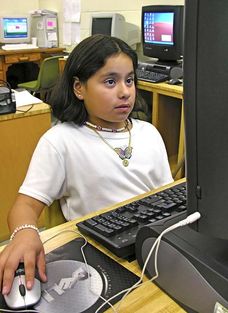
Sandberg cites a 1999 study suggesting stereotype threat undermines the performance and interest of girls and women for STEM careers – Science, Technology, Engineering, Mathematics. She writes that it “is one of the key reasons that so few study computer science” (Ch 1).
There is no question that women are underrepresented in computer science (CS) and information technology (IT). Stereotype threat may be one factor. Stereotyping by others is another. In 2006 Karen Scales, Mary Ann Edwards, and I published a study about women in IT. Several studies we reviewed addressed socio-cultural assumptions:
-- Women receive less encouragement to master computer skills than men do (Smith, 2005).
-- Educators are influenced by socio-cultural assumptions about IT and computer science and “steer women away” (Ray et al., 1999).
-- Some teachers (17%) and guidance counselors (12%) discouraged young women from IT (Turner et al., 2002).
-- To quote one director of undergraduate computer science programs, “Somehow teachers . . . are pushing the idea that this is not a field for girls” (in Grupta & Houtz, 2000).
-- In Malaysia women and men pursued undergraduate computer science degrees in near equal numbers. Key CS/IT university administrators and the majority of the computer science faculties were women. Because of the prevalence of female role models and mentors, for young Malaysian women “pursuing a career in CS/IT is a normal, indeed, unremarkable option” (Othman and Latih, 2006, p.114).
What determines whether of not a woman pursues computer science or IT? To quote from our study:
-- Adya and Kaiser (2005) concluded, “parents, particularly fathers, are the key influencers of girls’ choice of IT careers” (p. 230).
-- Turner et al. (2002) surveyed members of Systers, a listserv for women in IT. For the 275 women who responded, fathers were cited as encouraging by 42% and high school teachers by 37%. For women who earned an undergraduate degree in IT or computer science, by far the most important influences on their career choices were family and teachers, the most frequently mentioned influence being fathers.
The Systers survey also found that only about one third of women in their IT survey had majored in computer science or IT as undergraduates. Richard Rashid, a senior vice president at Microsoft in 2005, suggested to educators, “You need to talk about the romance of the field. It’s not all about people sitting in cubicles eating pizza and typing away endless hours on a keyboard” (Foster, 2005, p. A32). We agree. We found about 90% of the women in our study perceived computer and IT careers as creative activities.
Women are underrepresented in CS/IT. But there are factors we can address individually and institutionally – assumptions about women in IT, the role of teachers, the role of fathers, the way we market computer science and IT.
For references for the above cited studies, see Ballard, J., Scales, K., & Edwards, M. A. (2006). Perceptions of information technology careers among women in career development transition. Information Technology, Learning, and Performance Journal, 24 (2), 1-9.
Image by J. Baxter from http://www.flickr.com/photos/judybaxter/45972711/
Permission: http://creativecommons.org/licenses/by-nc-sa/2.0/deed.en
 RSS Feed
RSS Feed